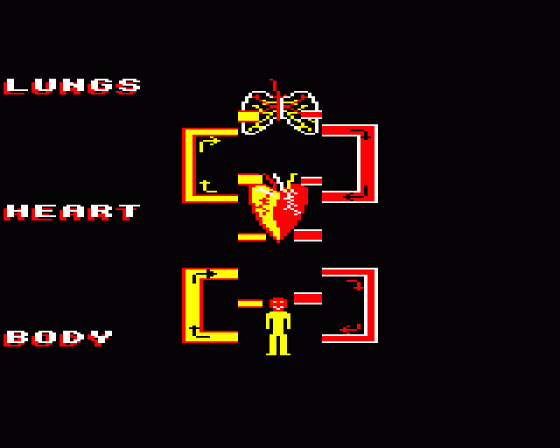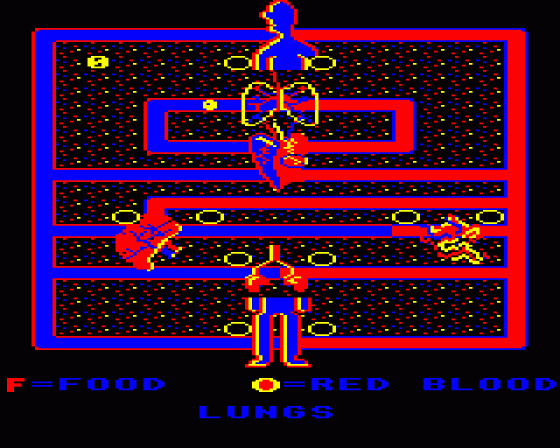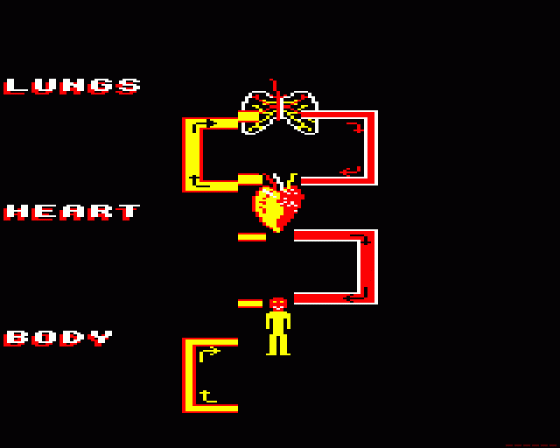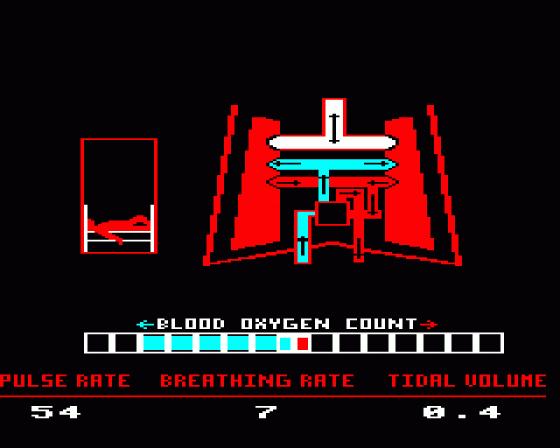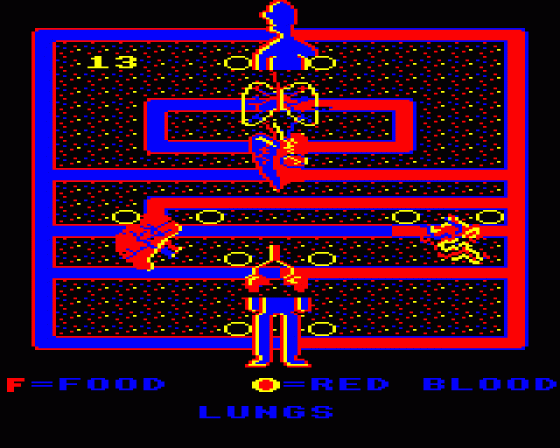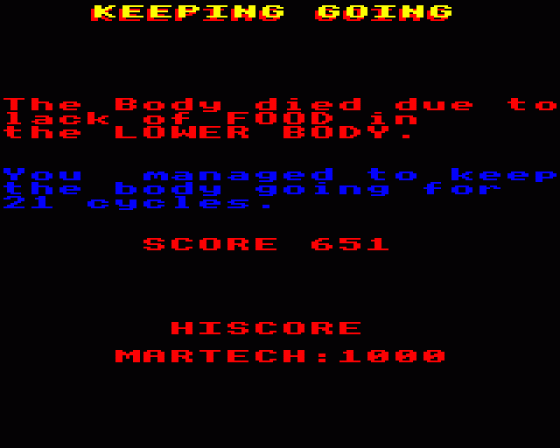Something Completely Different
Whilst the Electron is no stranger to educational games - it's famously got a little-known whole publishing company devoted to Shakespeare, for example! - all of them are famously dull. Up until now I had only really found one game that had, let's say 'pleased' me with its gameplay - the excellent Crack It! Towers. Now I've found something altogether different. The Living Body, a selection of six games. The package states it's for 'children and enquiring adults' and allows them to "discover, understand and even control the workings of the living body".
Um, well, yes; as someone who covered up his GCSE Biology failure (and has insisted he only took nine GCSEs ever since!) The Living Body presented my own brain with a chance to practise some ambivalence. Should I accept that my interest in Biology will always be only limited to human reproduction, and leave the game unreviewed? Or, considering it's an extremely scarce title which wasn't reviewed by the Acorn press at all during the Eighties, should I seize it and delight in this chance to further my very limited knowledge of all things blood- and oxygen-related?
I've chosen the latter, gingerly attempting to digest (not literally) the 32 page illustrated booklet, the 8 page program instructions and the gigantic clamshell box. However, after reading them all from cover to cover, I can actually say I'm still not sure if I'm any the wiser. Either my brain simply refuses to learn about this sort of stuff - or the instructions are unclear, littered with inconsistencies and depend upon the player being in the middle of his Biology studies to make any sort of sense.
Let's start therefore with just a roll-call of inclusions.
Inside Your Insides
Certainly game number one is easy to describe. That's because it's just a fairly run-of-the-mill "guess the body part" game. You get a nicely-drawn x-ray of a human body. Protruding from it are a number of labels which you can dance between by tapping the cursor keys. If you think you've spotted a body part that is distinctive enough to name, you can announce "I'll name that epiglotis in one, Lionel," and eagerly hover your finger over the E key as you hit RETURN. Yes, if that succession of events has confused you (quite outside of the odd reference to Lionel Blair, that is), allow me to elaborate.
When you're ready to take a guess you would imagine you would type in the answer. Oddly though, this isn't how the game operates. Instead when you are ready to give an answer (i.e. when you've worked out what it is), you hit RETURN. The whole screen then blanks into a Text Mode and you are given one of eight choices. Even more weirdly, a cursor bounces between each option and you have to hit the first letter of the correct answer when the cursor is highlighting the correct word.
Going Round In Circles
Game number two involves assembling a circulatory blood system and is an arcade, um, 'experience' - I couldn't bring myself to write the word game. You are shown the body, the heart and the lungs. Almost 'biology textbook fashion', the circulatory system between the two organs around the body is delineated with a red oxygenated blood passageway and a yellow deoxygenated blood passageway. The problem is that the circulatory system is bouncing up and down like Zebedee, with the different veins and arteries needing to be properly positioned to make the diagram make sense.
This (similarily to games four and six) is all done with machine code finesse. The idea is to hold down different keys in order to connect up all the different body parts at one exact moment. Why this is so important isn't really explained. It's fairly clear after about a minute how everything is meant to fit together too - so I'm not quite sure what you're learning by watching it all fly constantly out of control. But well anyway, that's game number two.
Get Me A Doctor!
Game number three is a Heart Operation in which you are referred to the booklet and then told to put the following sequence of events into the right order:
- Ventricle pistons push
- Atrio ventricular valves open
- Semi lunar valves open
- Atrium pistons push
- Atrio venticular valves close
- Semi lunar values close
I was hoping the booklet might give me the correct sequence but it doesn't so after hopelessly trying 'Mastermind-style' to guess (123456, 123465, 123465, etc.) I had to draw a blank. I guess unless a doctor reads this review and e-mails me the answer, I will therefore never get to operate the mechanical heart. Shame.
That Ain't Regulation, Soldier!
Still, no matter... because game number four is all heart-based too. In probably the best of the six games, this one involves you attempting to regulate the tidal volume and breathing rate of a computerised person. It's as if the heart stops working instinctively and you take over its job. If you don't take deep enough breaths or breathe too quickly or slowly, you'll find your subject hyperventilates or underventilates. What's nice about this simulation is that you get little animations of a man sleeping, playing on his computer, walking and... well, he probably does do something else but, due to lack of concentration on my part, he fainted.
This game is played with the arrow keys and, as with game number two, it's quite a polished job, all running in machine code with sound effects and arcade touches galore. The beating heart is particularly impressive, although I'm not too sure if it's really very addictive to play. You can learn the heart's "moods" by all means - but is the knowledge actually useful? Really?
I Smell Singed Hair Smell
And then we have game number five, Adventure In Digestion. The idea of this is that you are wandering around inside a human body trying to add the correct substances that you find in the alimentary canal. You'll find amylase, maltase, sucrase, lactase, ... ok, are any non-biologists still actually reading this?! Any semblance of playability that a game of this ilk could have is quickly destroyed by a navigation system that is, quite frankly, barking. To give but one example, Key T picks up an object, and acid is object 3 so to pick up one unit of acid, type T3. Then move F(orward), D(own) and L(eft) if you feel body temperature rising above 37 degrees C - because that means there are bacteria on the rampage.
This game is noteworthy for one thing only - befuddled by the confusing command system and being the world's worst Biology student, I wandered in what I believed to be the direction of the bacteria, randomly chucked acid at it and found I had dissolved my own hair. At which point the computer gave me a severe dressing down and after that I was 'sacked' and Lord Sugar appeared to tell me so. OK, one of these last things isn't true.
Your Body Has Died
Finally comes game number six, again inviting you to take control of the blood flow of a living body. This one is slightly easier though. Firstly, the various parts of the body are displayed in a "Rogues' Gallery" on screen - with the letters you must touch next to them! - before it starts. Secondly, the letters you need to type to get blood to them are instinctive - G for Gut, K for Kidneys, etc.
When the game itself starts, you also find this is another very polished number, running at a fair pace. Each part of your body (i.e. liver, upper body, lower body) will signal when it requires oxygen by beeping at you. A symbol next to it also either turns to red or to a big 'F' indicating oxygenated blood or food is required (as appropriate). If it's blood you go ahead and tap the appropriate key. If it's food you need to go to the Gut first (via key G), then deliver it to the Liver (or whatever) by the necessary pressing.
As with game four, you are here learning a 'cycle' which, with some practice, means you can give the heart going for longer and longer periods. However, again I question whether this is really useful as "knowledge"? Also, when the lower body and upper body light up simultaneously you of course have to choose which one to deliver the food to - and then get told that 'Your body has died' due to last of sustenance to the other one.
So What Have We Learned?
Now, if you've managed to glean anything at all from the above descriptions, then you might like to check out The Living Body. So in order to tempt you, let me make it clear that, in terms of quality of production (and Adventure in Digestion aside) this is one of the best 'educational' titles I've ever seen. There are no long pages full of text, no multiple-choice questions and definitely you don't end up feeling like you could have had the same experience by just reading a textbook.
Nevertheless, The Living Body is pretty far from perfect. The blurb describes it as 'challenging, exciting and very enjoyable'. But I would describe it as 'bewildering, at times excrutiating and very comical'. I sort of imagine an army of Biology Geeks thinking it's the best thing since sliced bread because they were intelligent enough to keep the circulatory system going for an hour, or they managed to get through Adventure In Digestion without singeing off their own eyebrows. But us normal Geeks [People shurely? - Ed] get very little from it.
It doesn't help itself by having massive inconsistencies in terminology between the booklet, the instructions and the game itself. The mechanical heart sequence, for example, is meant to be outlined in the booklet - but the booklet mentions only the atrium walls, the atrioventricular valves and the ventricle walls. So the 'semi lunar valves' are a complete mystery to the player without further study.
If you are interested in how the body works, there is enough information in this program, and the associated documentation, to stimulate the user. But in conclusion, whether it be from my lack of interest in these things or because how to win some of the programs is shrouded in mystery, I lean more towards recommending you give it a miss than a go.


 31st December 2011
31st December 2011







